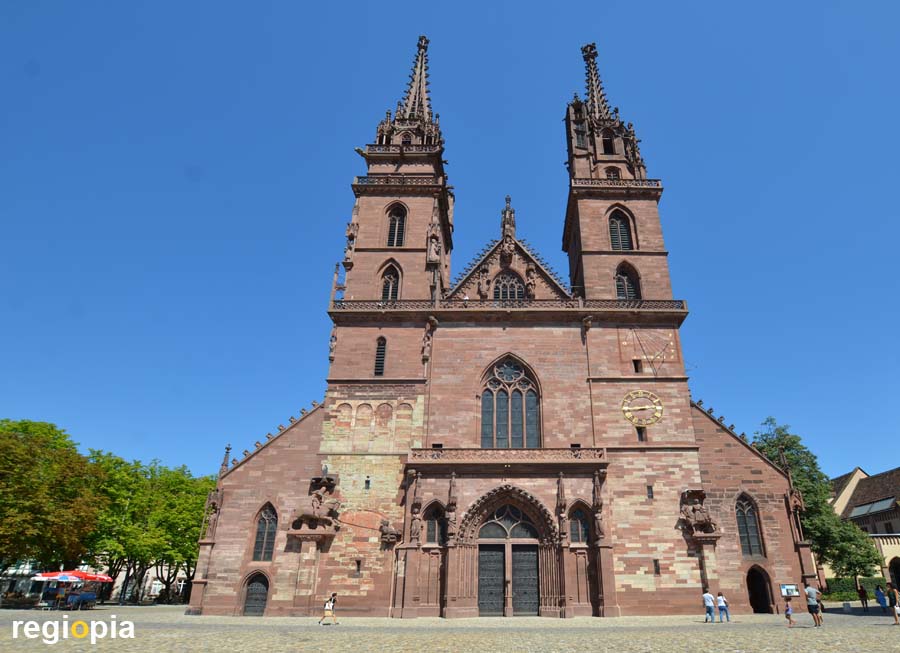
Basel Minster
The most famous sight is the Basel Minster. The cathedral stands on a hill above the Rhine and can be seen from afar. The main facade with the two 67 m high bell towers is located in the south-west, on Münsterplatz. Traces of settlement from pre-Roman times have been found on the Minster hill. The Romans built a fort here, but their city was in Augusta Raurica, a town about 10 kilometers east of Basel.
The first church was built here around 820. The first Romanesque cathedral was inaugurated here in 1019, from which the light-colored stones in the facade remained.
The Basel Minster as you can see it today was built between 1180-1500. That was the time when the Romanesque became Gothic. As a result, the cathedral is a late Romanesque and early Gothic building, as both architectural styles can be recognized. Most of the minster was built in the 12th century. The two Gothic towers were designed by Ulrich von Ensingen in 1414. The same master builder also designed the Ulm Minster, the tower of the Strasbourg Minster and the tower of the Imperial Cathedral in Frankfurt am Main.
At the Georgs tower you can see the dragon slayer Georg and at the Martin tower Saint Martin is dividing his coat. You can climb the two towers and see the Black Forest or the Jura Mountains behind the roofs of Basel.
The Gallus Gate on the north facade is also worth seeing. Because of the ornate decorations, it is considered the most beautiful Romanesque portal in Switzerland. The nave is 65 m long and 32 m wide. It is spanned by Gothic ribbed vaults. The bones of the Basel bishops lie in the crypt.
In the south-east of the minster is the double cloister, which was added as the last part of the cathedral in the 15th century. The two inner courtyards are separated by an open hall, above which the cathedral hall is located.
If you walk on the north-west facade towards the Rhine, you come to a viewing terrace from which you can see over the river to Kleinbasel.
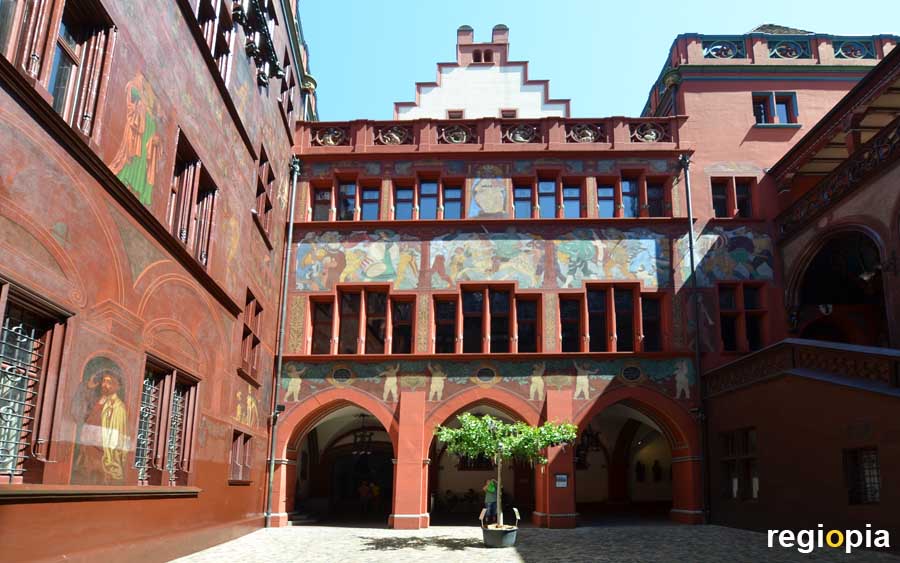
Basel City Hall
The Basel city hall is an absolute highlight. The magnificent city hall was built between 1504 and 1514 after the great earthquake. However, the medieval town hall only consisted of today's central part. The town hall tower on the right and the building with the bay window on the left were added in 1904. The Basel town hall stands out due to its bright red painting, which in turn shows wall paintings by Hans Bock the Elder. In the inner courtyard is a statue of the Roman general Lucius Munatius Plancus by Hans Michel. Plancus is considered to be the founder of the Roman settlement on today's cathedral hill and the Augusta Raurica colony near Basel.
The town hall of Basel is still used today as the city's parliament.
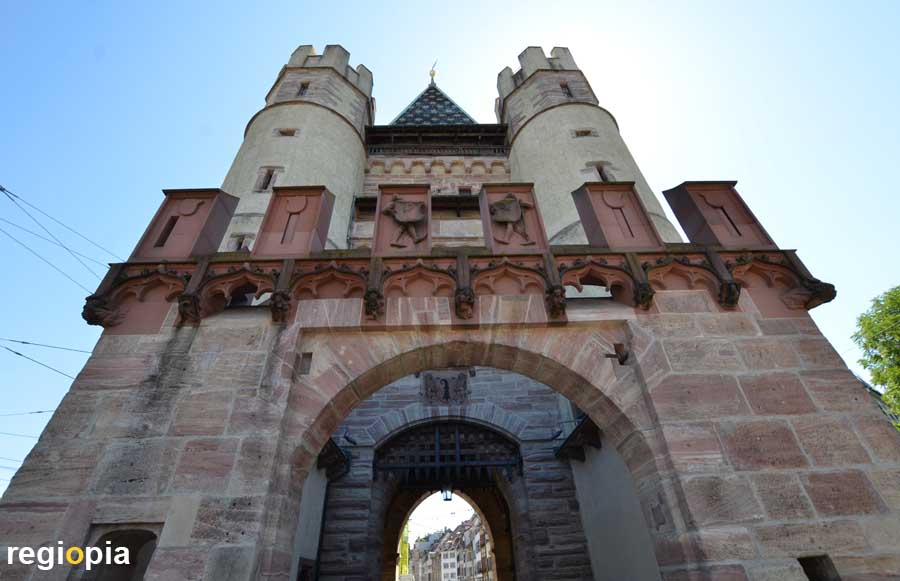
Spalentor
The Spalentor is a gate in the former city wall of Basel, which was built around 1356. The Basel city fortifications originally had 7 gates, 3 of which have been preserved. In addition to the Spalentor, the St. Alban-Tor and St. Johanns-Tor survived the demolition of the city wall from 1860 onwards. The Spalentor is the most beautiful city gate in Basel and one of the city's sights.
Basel had a city wall since 1080, which is now called "Inner City Wall". The Spalentor is part of the "outer city wall", which was completed in 1398. A section of this wall has been preserved between the St. Alban-Tor and the Rhine.
The Spalentor was a representative city gate because it was on the road to Strasbourg. The name Spalen probably goes back to the word stake. The suburb was protected by a wooden palisade before the city wall was built. The settlement between the "Inner City Wall" and the palisade was called Spalenvorstadt. The gate stood directly on the moat, over which a drawbridge led. It is around 40 m high and is flanked by two smaller towers. The roof is covered with green and yellow glazed tiles. On the facade you can find artistic decorations and the coat of arms of the city of Basel.
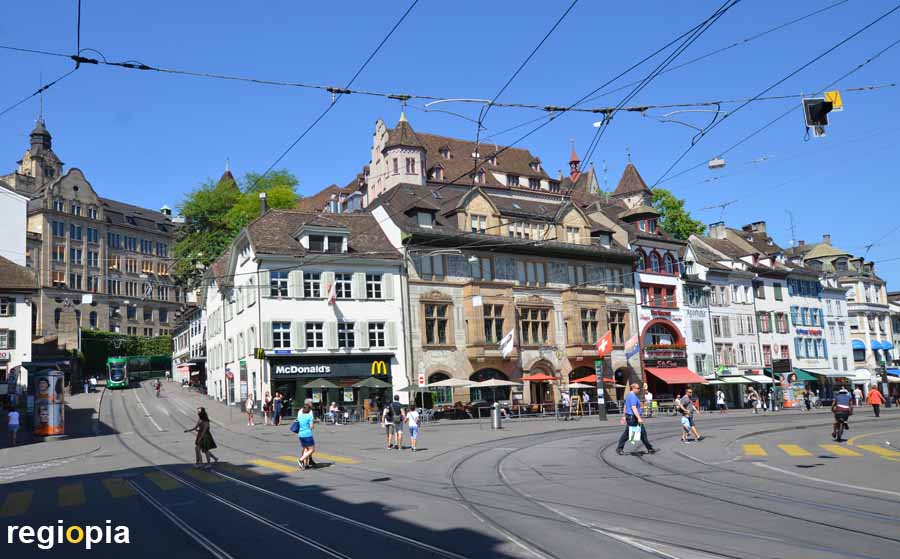
Barfüsserplatz
The Barfüsserplatz is the city center of Basel. Several tram lines cross the square, the tourist information office of Basel and the city's historical museum are also located here. The pedestrian zone that leads to the market square also begins at this place. The name Barfüsserplatz comes from the monastery of the Franciscans, who were also called Barfüsser (barefoot) in German-speaking countries. The historical museum is located in the former Barfüsserkirche. The Brasserie "Zum Braunen Mutz", to the west of the square, is one of the most famous restaurants in Basel.
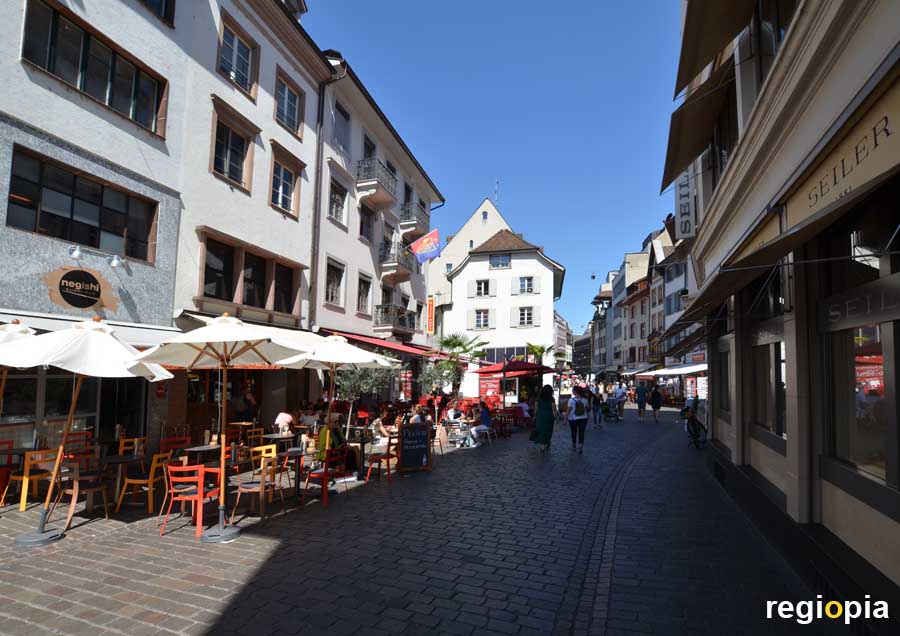
Gerbergasse
Gerbergasse is the main shopping street in Basel. The approximately 200 m long pedestrian zone connects Barfüsserplatz with the market square. In addition to numerous shops, there are also cafes and restaurants on Gerbergasse. The "Walliser Kanne" restaurant serves Swiss specialties such as cheese fondue, fish and raclette. Those who still need souvenirs will find delicious baked goods and chocolate specialties in "Confiserie Bachmann". The "Unternehmen Mitte" in the former Schweizer Volksbank is a cultural institution. A foundation bought the bank and leases the building at cost to various operators who serve the common good. On the ground floor, there is a large cafe in the former counter hall.
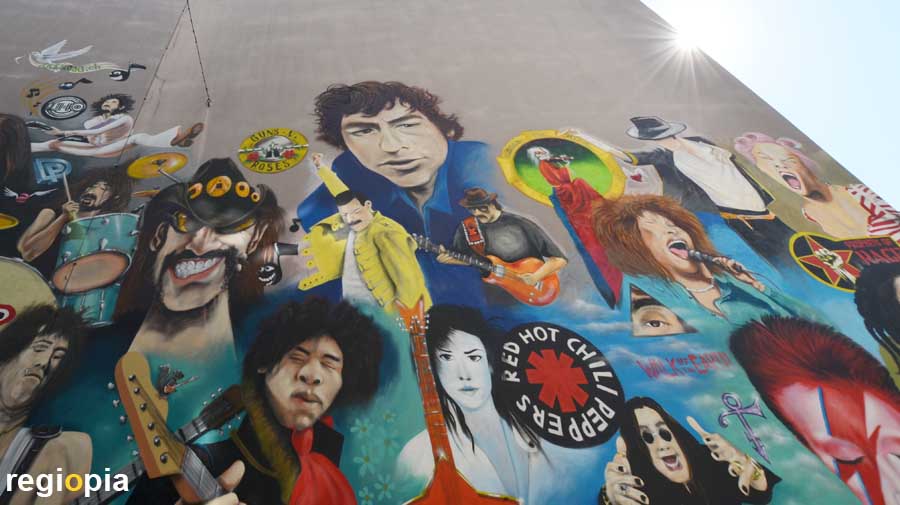
Gerbergässlein
Gerbergässlein is a street parallel to Gerbergasse. The small side street is typical for the old town of Basel. Here is Basel's top Instagram spot, a huge graffiti with the world's most famous rock legends. The wall painting WALL OF FAME was sponsored by L'Unique, a rock bar with gallery and museum, which is located opposite to the mural.
ads
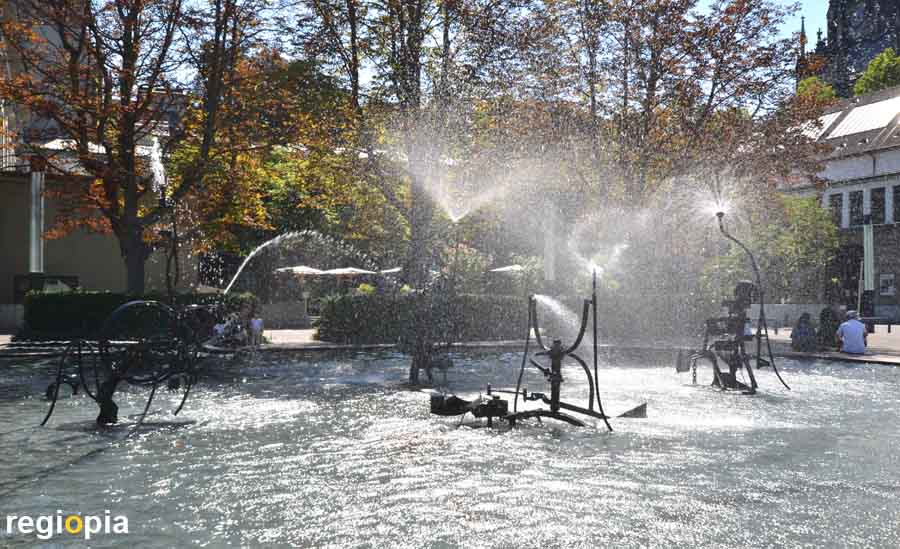
Tinguely Fountain
The Tinguely fountain is a landmark of Basel. Jean Tinguely was a Swiss artist who grew up in Basel and became famous in Paris for his movable metal sculptures. In Paris in front of the Center Pompidou is his most famous work, the "Fontaine Stravinski", which he built with his wife Niki de Saint-Phalle.
The Tinguely Fountain in Basel was built in 1977 on the site of the former theater. Tinguely used materials from the old theater for the moving figures. The kinetic work of art is also known as the "Carnival Fountain". If you want to see more works of art by Tinguely, you can go to the Tinguely Museum in Basel.
On the square in front of the theater there is also a sculpture by Richard Serra.
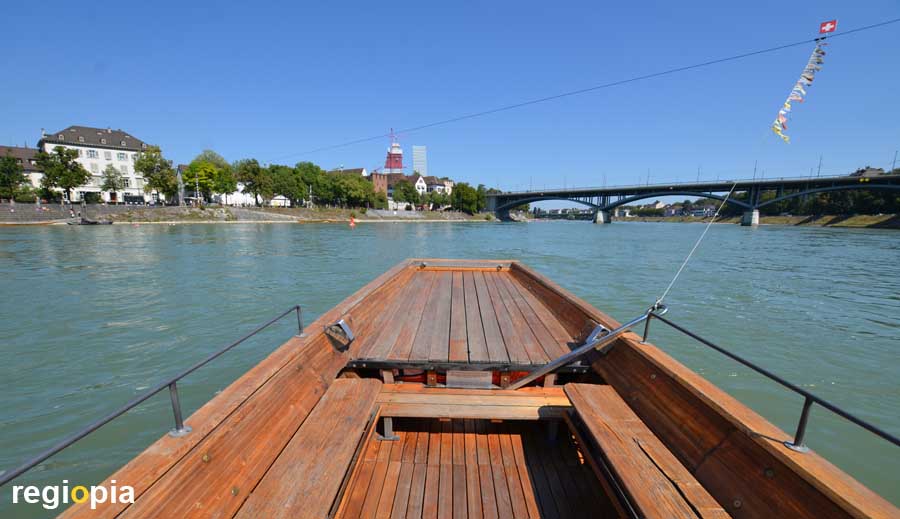
Basel Ferries
The Basel ferries are a well-known attraction of the city. The ferries do not have a motor, they are only moved by the current of the river. The ferry hangs on a steel cable with a rider pulley, the sloping position of the boat pulls the ferry to the other bank. By building bridges, the ferries no longer paid for themselves and were saved by an association that still operates the Basel ferries. There are still four ferries across the Rhine. The best known is the Münster ferry called Leu. There is also the St. Alban ferry "Wild Maa", the Klingental ferry "Vogel Gryff" and the St. Johann ferry "Ueli".
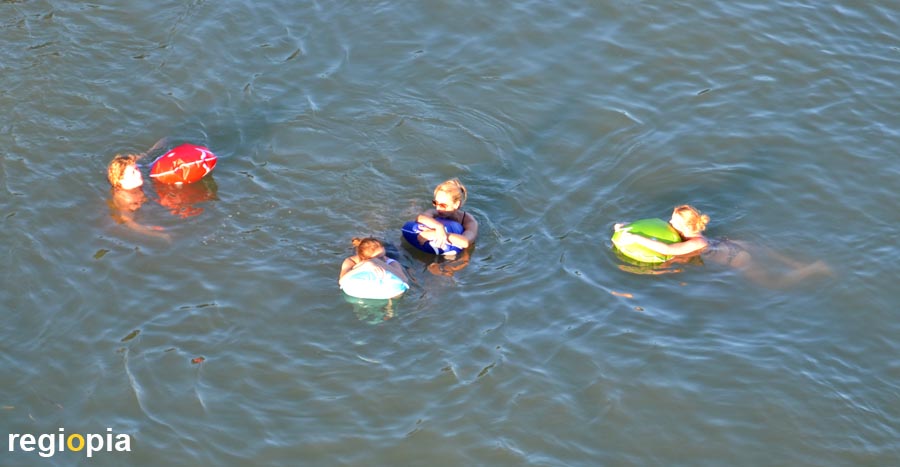
Rhyschwimme
The Rhyschwimme (Rhine Swimming) is a very nice specialty of Basel. You let yourself be drifted through the city center by the current of the Rhine. All you need is a "Wickelfisch" (wrapped fish). The wrapped fish has become a landmark of Basel, because in summer thousands of people step into the waters of the Rhine and float on the river like colorful confetti. The wrapped fish is a colorful, fish-shaped carrier bag that is waterproofed by being wrapped around 7 times. You can put your clothes in the bag and get dressed again after a swim in the river. In addition, the bag gives buoyancy and makes bathing very relaxed.
Due to the strong current, it is still exhausting because you have to keep your position constantly to avoid being drifted into the ships' fairway. Swimming against the current is not possible. If you want to get out again, you should get close to the shore in good time.
The entry point for swimming in the Rhine is at the Tinguely Museum. If you are doing a Rhine swim for the first time, you should get off on the beach in front of the Wettstein Bridge. The current is dangerous at the bridge piers, you should aim for the middle between the piers. The exit after the Wettstein Bridge is a little more difficult, because there are only a few points in the city center where you can pull yourself out of the river on an iron chain. But that's not a problem for experienced swimmers. Not skilled swimmers should not swim in rivers at all, it is dangerous.
www.basel.com/de/Rheinschwimmen
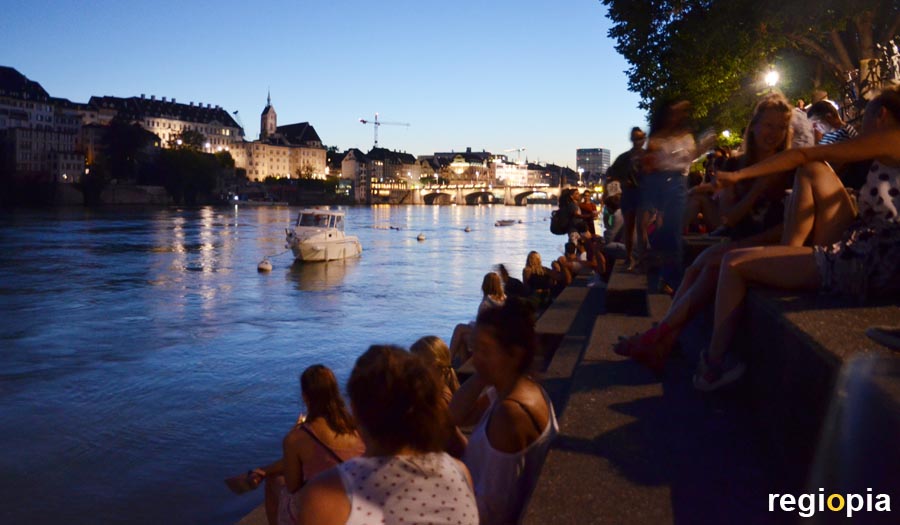
River bank
The banks of the Rhine in Basel are called "Riviera" by the locals. In summer, the riverside is the heart of the city. The stairs on the Rhine get crowded in the evening. You can have a drink or have a picnic with a view of the cathedral. The busiest place is on the Kleinbasel side between the Johanniterbrücke and the Wettsteinbrücke. There are also a few restaurants along the river, where you can enjoy Basel's banks of the Rhine. The Cafe Spitz at the Mittlere Brücke is very popular because of the beautiful view. The Cheval Blanc in the Grand Hotel "Les Trois Rois" is the best restaurant in Basel, with a terrace on the Rhine. It is also very nice to sit in Le Rhin Bleu on St. Alban Rheinweg.
Tourist Map Basel
ads
Travel Guide Basel
ads
ads


